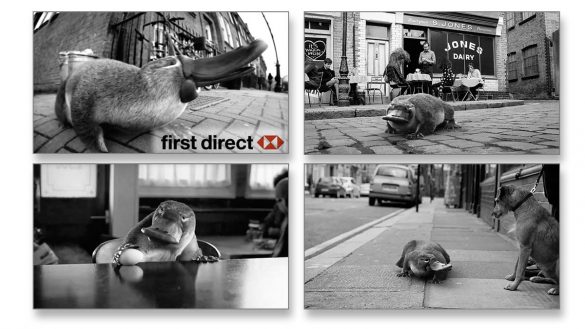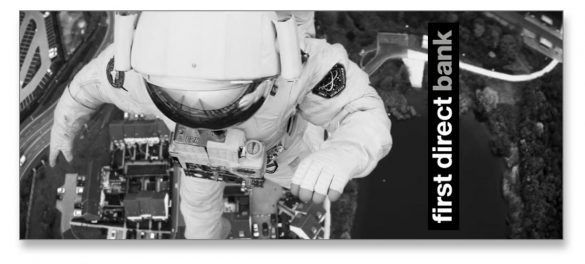In the age of Monzo, Chime, Revolut, Atom Bank and other challenger banks, most people in banking forget about First Direct and the pioneering work it did, if they ever knew about it at all.
At least a couple of challenger-bank CEOs, in fact, hadn’t been born when First Direct was launched. Even the bank’s CEO, Joe Gordon, was just five when the U.K.’s first branchless bank opened for business at 12:01 a.m. on a Sunday morning in October 1989.
“The idea that customers could handle their banking over the phone from the comfort of their own sofas, rather than queuing in tired local branches, was revolutionary in 1989.”
— Zoe Burns-Shore
“It is easy to forget how big a deal it was when Midland Bank launched First Direct,” former First Direct CMO Zoe Burns-Shore tells Campaign. “The idea that customers could handle their banking over the phone from the comfort of their own sofas, rather than queuing in tired local branches, was revolutionary.”
Yes, but that was almost 30 years ago. What are they doing now?
Amazingly enough, First Direct, under a series of leaders, has reinvented itself multiple times, and is fully embracing the new open banking regime in U.K. What makes this story even more interesting is that the scrappy, push-the-envelope mindset that launched this 24/7 banking provider originated under the staid auspices of Midland Bank, one of Great Britain’s big five High Street banks. And the same attitude continued after Midland was acquired by HSBC in 1992.
But even with many advances and upgrades at the bank during that time, one thing has not changed at First Direct: access to live bankers 24 hours a day 365 days a year.
First Direct has never been closed since taking its first call nearly 30 years ago. The First Direct call center received 1,000 calls that first day, ushering in the era of direct banking, long before most banks and credit unions had even thought of the concept. Now First Direct bankers handle not only phone calls, but texts, emails, chat, tweets, and more.
Currently, 85% of First Direct customers are active online banking users, and mobile banking became the bank’s number one channel in the Fall 2018. On average, First Direct customers interact with the bank through digital channels about 25 times more often than they call. However, the bank maintains the personal touch even here, with the majority of its tweets signed with the first name or initials of the employee responding. Being able to connect digitally or by phone with a real person, any time it’s convenient for you, remains a core differentiator for First Direct.

Move the Needle from Attrition to Acquisition
Vericast’s 2024 Financial TrendWatch explores seven of today’s most critical financial services trends to provide a complete view of the current loyalty landscape.
Read More about Move the Needle from Attrition to Acquisition

Send the Right Offers to the Right Consumers
Achieve a better return on your marketing investment. Leverage behavioral data and analytics to target the right customers with the best possible offers.
Read More about Send the Right Offers to the Right Consumers
A Modern Challenger, But With More People
What began as a 24-hour telephone banking operation has since seen numerous enhancements:
- PC banking in 1997
- Text banking in 1999
- Internet banking in 2000
- First-generation mobile banking in 2006 (before the iPhone)
- Voice authentication in 2016
- Native mobile app in 2017
In almost every case, First Direct was early, if not leading, in offering these new features.
In fact you could argue that, with one exception, First Direct is as much of a challenger bank as much younger rivals like Revolut and N26. The exception is its massive contact-center operation. This clearly sets First Direct apart, in terms of around-the-clock personal attention. Still, it is an expensive proposition given the cost of hiring, training and paying a small army of people. The bank has about 2,800 employees and operates two contact centers in the U.K. While that model is not as expensive as maintaining a branch network, clearly it’s a bigger ongoing expense than what the digital-only startups contend with.
Read More: Eight Challenger Banks Traditional Institutions Should Worry About
Highly Personal Service Builds a Loyal Base
Expensive or not, the personal-contact-plus-digital model has worked well. First Direct has been profitable every year since 1995, the company states. Not only that, the bank has for years ranked at, or near, the top of various customer satisfaction and recommendation rankings in the competitive U.K. banking market.
Since the middle of 2018, Britain’s Competition and Markets Authority (CMA) has required financial institutions take part in a biannual review of service quality, and to publicly display their scores. First Direct aced the first round, capturing the top spot in all three of the categories that applied. In the second round it lost one of the top spots (“Would you recommend the brand”) to arch rival Metro Bank by a couple of points.
There’s always room for improvement, however. On at least one bank rating site, Trustpilot, the poor or bad consumer ratings outnumbered the good for First Direct as of mid 2019. Many of the complaints related to unexpected wait times on calls, and some problems with new security regulations The bank responds politely to every negative comment, as well as to the good ones, not only on its own Twitter help feed, but on the review sites.
Despite some glitches, First Direct’s service reputation would be the envy of many financial institutions —traditional or challenger — especially when looked at over three decades. It’s high level of personal attention builds loyalty. The bank states that 80% of its original first-year customers are still with it. Further, KPMG reports that in 2016, First Direct had a Net Promoter Score of +73, a full 30 points ahead of any other banking provider in its market.
And while its total customer base — about 1.45 million, by one account — is modest compared with newer challenger rivals —such as Monzo, which has already passed two million — almost all of First Direct’s accounts are current (checking) accounts, which is not the case with many of the newer challenger banks.
Read More: Financial Institutions Must Kill Pain Points in Their Customer Experience

True Challengers Need Disruptive Marketing
Launching a 24-hour branchless direct bank in 1989 called for some extraordinary marketing. Commendably, First Direct’s parent, Midland Bank, gave the startup a free hand.
The launch campaign that followed, ripped up the usual rules. The initial TV launch ad, all in black and white, purports to be a message sent back from 2010. A young woman “hacks” hacks into an Audi ad appearing jerkily on screen talking about the 21st anniversary of First Direct. Viewed now, the ad looks funkily retro, but the shock value worked back then and within eight weeks of launching, First Direct had the highest awareness of any brand, according to Marketing Week.
A few years later, the upstart brand, feeling like it needed to return to its scrappy and irreverent roots, came up with an equally remarkable TV spot — still in black and white, the company’s preferred palette — starring “Barry,” an affable platypus that walks around London talking about his favorite bank. To this day, First Direct may be the only financial institution to have used a friendly talking platypus in a TV ad, but it was a perfect fit: the world’s most oddball animal — seemingly half bird, half mammal — talking about an offbeat, friendly bank.
Fast forward a few years and First Direct’s marketing team had to wrestle with the challenge of making people aware of how the brand had evolved into a modern, digital institution. “Over 80% of our customers bank with us through digital channels, but we’re still thought of as a phone bank — that has to change,” Zoe Burns-Shore told Campaign. A new TV ad featuring a gravity-defying astronaut bouncing around London, was part of an overall campaign that sought to raise awareness of the bank’s voice ID capabilities, innovative mortgage plans, and mobile app.
“The reality is good customer service now comes with the territory — it’s just something people expect in the Amazon age,” says Burns-Shore in a Marketing Week interview. “On its own, it isn’t enough of a brand differentiator anymore. It’s a great way of keeping customers, but to gain new ones, repositioning the brand in a more modern way makes the most sense.”

Open Banking, a ‘Massive Opportunity’
Possibly the biggest challenge First Direct faces is how to keep its high level of personal service intact in a world where consumers increasingly bank digitally. With digital-only startups abounding, especially in the hot U.K. challenger-bank market, some have wondered if consumers may perceive pioneer disruptor First Direct as obsolete.
That seems unlikely to happen under CEO Joe Gordon’s stewardship. The Millennial executive, who arrived in 2017, spearheaded First Direct’s test of an open banking app, called Artha, built in conjunction with the fintech company Bud, as part of HSBC U.K.’s open banking strategy. The trial ended in March 2019 and First Direct is integrating some of the most useful features into its mobile app, including helping consumers to reduce fixed monthly costs for utilities and other services, aiding first-time auto buyers and increasing financial wellbeing.
Gordon tells BBC he sees open banking, effective in the U.K. since early 2018, as “a massive opportunity for us.” The Artha app test was all about a chance for First Direct to “own the relationship,” he says. Open banking in the U.K. requires the major banking providers to allow third-party access to customer account data. It is intended to increase competition and choice for consumers. However, it has also increased consumer confusion in the short term. That creates an opportunity for a financial brand with a high level of trust to help out. Other U.K. institutions have recognized the potential of open banking, as well, but overall the reaction has been more compliance than innovation.
With the Artha app, consumers could bring together accounts from the largest banks, enabling the technology to categorize their spending data. As Gordon relates in an interview with This is Money, this capability effectively makes First Direct a personal finance manager for consumers, and not necessarily just those who are already customers.
“We can see how you are spending your money,” Gordon says. “If you’ve got your money with this utility provider, and if you give us consent through open banking, we can make a recommendation to say: ‘You know what? It would be cheaper if you switched that’.”
“Amazon’s great at telling me what the five-star-rated screwdrivers are. We have the opportunity in banking to do the same sort of thing.”
— Joe Gordon, First Direct
Gordon believes First Direct is in a perfect position to make these recommendations, and help “bust the stress of choice,” because the bank is trusted by consumers. That’s an advantage that new challenger banks such as Monzo and Starling have yet to build, he believes.
The confident CEO isn’t cowed by talk of an Amazon bank either. Rather than see the ecommerce giant as a threat, Gordon sees it as an example to follow.
“What Amazon’s great at, for me, is if I need something like a screwdriver, they will tell me what the top five-star-rated screwdrivers are,” the banking exec tells This is Money. “We have the opportunity in banking to do the same sort of thing.”
Helping First Direct stay on the leading edge, is its “fdesign Mobile” co-creation lab in which a “few thousand” consumers become directly involved in developing new products and services. “fdesign Mobile helps us to put more products and services through their paces, faster, working out niggles and helping us create a truly modern and open banking service that’s right for now and the future,” Gordon states.










